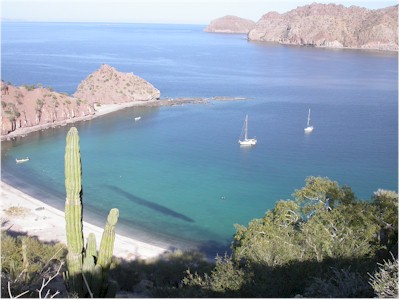
Gorgeous Agua Verde
 |
|
Gorgeous Agua Verde |
By the time we climbed out of bed on our second day in Puerto Gato, we found a light SE wind blowing. This was unfortunate as our anchorage here was not protected from that direction at all, but great as it would provide a fine downwind sail for us on our way to our next anchorage north of us, Agua Verde. We were excited to get to Puerto Agua Verde ("Green Water Port") as we'd heard it was one of the most beautiful spots on the coast.
We spent the morning trying to make our way north in light southeasterly winds with all sorts of sail configurations -- genoa only, main and genoa wing and wing, genoa and spinnaker wing and wing -- trying our hardest to drift northward as far as we could in the light wind. It was a nice challenge, and a quiet peaceful day but by 1300 when we started sailing backwards we decided it was time to commence with our transmission testing and motor the last 5 or so miles to Agua Verde.
We anchored in the northwest bight of Agua Verde, surrounded by tall almost vertical desert cliffs, cacti clinging precariously to the cliff sides. The water indeed was a clear emerald green and made a beautiful contrast to the red desert cliffs and white sandy beaches. There were more great rock formations here, including Roca Solitaria, a 100' tall rock spire bursting from the sea at the entrance to Agua Verde, and Pyramid rock shaped just like that at the southern end of the bay.
Birds love to perch on the rocks which leave large piles of guano, and in this guano is where the dreaded Bobo flies either breed or hang out and we were soon covered with them again if we ventured into the cockpit. So we quickly headed ashore to explore. We found a quiet small goat herding village, covered with goats and their small kids. Also, sadly lots of trash largely in the form of plastic bottles that seem to be piled all over every Mexican town we've visited.
|
Agua Verde goats |
For the first time in about a week and a half, we finally had a quiet, windless night's sleep. For most nights in the past two weeks, the wind would pick up during the night for a few hours in various directions. Luckily (unlike in Ensenada Grande) we'd been protected from the waves by land, but we'd still lay half asleep with the mast shaking and wind howling in the rigging. It was very nice to finally have a full night of deep sleep.
The following morning we donned our snorkeling gear (including our full wetsuits as the water temperature is still pretty cold, in the lower 70s) and headed over for a bit of snorkeling around pyramid rock. The water clarity was not so great -- only about 10 feet but there were still lots of colorful fish including schools of the yellow, blue and purple-gray striped Sergeant Major fish. We snorkeled over a shallow area just deep enough for us to hover over a vast forest of small purple corals without scraping our bellies. It was a mesmerizing clear spot with many plum-colored sea urchins, sea cucumbers and blue starfish.
It was quite hot that day, so we spent most of it under the shade of our cockpit cover or down below. We wanted to go hiking, so left at 5 pm when the air finally started to show a hint of cooling off. We followed a goat trail to the top of the hill near the anchorage, then hiked down the other side, past an ancient abandoned cemetery, through the flat green valley that lay on the other side of the hills surrounded by enormous rugged mountains typical of this coast -- just gorgeous with the sun setting behind them. Just as the blazing sun dropped behind the mountains, we found the dirt road that led back towards the anchorage. It was beautiful country with many small green trees, shrubs and cactus with lizards skittering along all over the sandy ground and hawks soaring overhead. The desert plants are so delicate, many with fragile miniature flowers you do everything possible not to step on, knowing if you do it's probably the end of them.
|
Great hiking country at Agua Verde |
Our final day in Agua Verde was still and hot. All over the anchorage we could hear the splash of people jumping into the water to chill off, so we did the same. Today, the cool temperature of the water felt amazingly refreshing and we were glad for once it hadn't warmed up yet.
We set out for Isla Danzante the next morning, another calm glassy morning just ripe for transmission testing. The transmission worked perfectly all the way to our anchorage on the island, Honeymoon Cove. The cozy northern cove already had two boats in it, so we dropped the hook off the middle bight. The ground dropped off from the beach very rapidly here, so although we were anchored in about 40 feet of water, we could practically swim to the beach in about a minute. Given the additional fact that our CQR anchor did not grab hold very quickly and the anchorage was open to all winds from SW to NW, we did not feel very comfortable there at all.
Isla Carmen and the reportedly well protected anchorage of Puerto Ballandra was only 14 miles north of us and the wind had finally picked up a bit from the E so after lunch we hauled anchor and headed up to Carmen. Finally we had some good sailing with the wind blowing from the E at 10-15 knots. Along the way, we tried our friends on Whistledown, a Spencer 35 similar to Pelican, who we'd last seen in La Paz as we thought they were in the area. Sure enough, they were in Puerto Escondido and said they'd meet us up at Isla Carmen that evening.
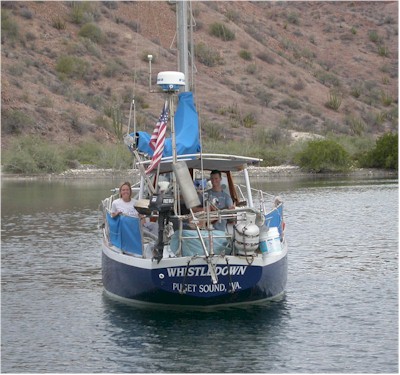 |
|
Meg and Doug of Whistledown |
We had decided not to go into Puerto Escondido, what is a very well protected anchorage surrounded by lovely tall mountains, as the Port Captain in the town of Loreto about 15 miles north of the Escondido anchorage requires that all boats stopping there check in and out of Loreto. This requires either taking a $50 taxi ride or hitching a ride into Loreto from the anchorage to pay your $35 fee to check in and out. We missed what is probably a beautiful anchorage, but thought this check-in requirement was absurd and expensive, so kept heading on to the many free anchorages in the area.
Once off Isla Carmen, the wind must have been veering around the island as it was now coming at us from the north. In only about 10 knots of wind, we made a few slow large tacks up to the anchorage. It was a nice mellow sail, the kind where you are just quietly drifting across flat water, the only sound being the gentle trickle of the boat's wake. The Ballandra anchorage had a narrow opening between two tall cliffs into the large round bay with plenty of room for anchoring (good holding too!) and enclosed by lovely desert hills and a small fisherman's camp. We had dinner with Doug and Meg on Whistledown that evening and as always it was great catching up with what our friends had been up to the past few weeks.
The next day the forecast was for calm winds, so Whistledown offered to take us and a new friend Fulvio from Soliton across to the town of Loreto, 9 miles west on the mainland for some sightseeing, pizza, and fresh produce and (maybe the real reason for the trip) beer. The ride over was very calm and they anchored off the town, which is an open roadstead anchorage but fine for a calm day like today.
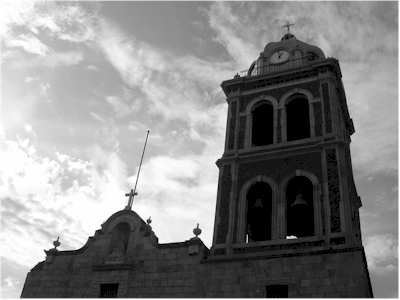 |
|
Misión Nuesta Señora de Loreto |
We loved the town of Loreto and wished we had more than a few hours to spend there -- it was clean and very friendly with interesting historical buildings including a lovely mission and cozy looking old hotels. We ate pizza at Tiffany's Pisa Parlor -- deliciously made by an Italian woman who's owned the shop for years. Even Fulvio, who is from Italy said it was great. We used the internet for the first time in two weeks, bought some fresh vegetables and were even able to fill our two water jugs near the dinghy dock.
Returning to Whistledown after sunset, we found a light west wind blowing, perfect for spinnaker flying! With all of us stationed at a line, halyard or pole, we hoisted Whistledown's bright yellow and black spinnaker, and drifted eastward back to Isla Carmen under a warm starry night sky lit by a perfectly full moon. It was a magical night sail, one we'll not forget.
Early the next morning around 1 am, the sound of a fresh SW wind woke us up. We listened to the wind coming right in the anchorage for a few minutes, then realized what had really woke us up were the horrified cries of "help us!!!" coming from the southern part of the anchorage where no doubt the boats anchored there were getting the brunt of the wind and waves. Michael stuck his head out of the hatch with the binoculars and saw a small 30' sailboat on it's side in the shallows off the beach. It looked like the little boat had drug anchor and gone aground not long before.
We quickly dressed and jumped in the dinghy to try to offer help. When we arrived we found the wind and waves indeed worse than where we were anchored in the northern part of the bay. The skipper of the small boat was busy putting out another anchor and was surround by several other dinghies along with ours full of people trying to figure out how to help.
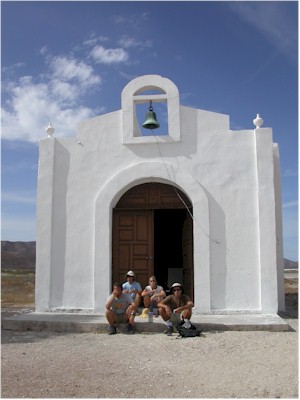 |
|
Resting our weary feet |
Whistledown had happened to be re-anchoring during that time, hoping to move in the northern more protected part of the bay; the only thing we could all think of to do was to get a tow line to them to attempt to tow the little boat off the beach. Just as we were about to hand the long line attached to the bow of the beached sailboat off to Whistledown, a bright light came toward us and out of the dark appeared a panga (the sturdy open fiberglass boats powered with large outboards that the Mexican fisherman use) full of fishermen from the nearby camp.
Cheering, we handed off the line to the panga and it wasn't long before it's 150 HP outboard had the small sailboat free of the beach and had led it to anchor safely in the northern part of Ballandra. We were all so grateful towards these brave fishermen to offer help and put their own livelihood that is their expensive panga in jeopardy, not to mention their lives in what is always a dangerous situation.
It was wonderful to see the sailboat anchored again, luckily not taking on any water. Tempers had flared every now and then during the stressful rescue, but all in all thanks to the brave panga drivers, everything turned out well in the end.
After sleeping in the next morning, we awoke to a cloudy and fairly cool day. With the crews of Whistledown and Soliton we decided it was a great day for a hike, so we set off across the island to the abandoned salt mine village Bahia Salinas on the other side. The hike was marvelous through a great narrow arroyo (dry stream bed) lined with tall red cliffs on either side of us, which opened out into a wide flat valley. The desert is so incredibly quiet and delicate in places like these -- you can listen to each individual bird call, hear the wind rustle the dry bushes and small trees, even hear the leaves crunch at lizards go darting off the trail. It's really a special, peaceful place.
We didn't have too much time to gaze at the still world around us, as he trail continued on for miles, over the flat valley then winding up the side of a steep hill; at the top we could finally see the old village and enormous salt evaporation ponds far below. We hiked down the other side, then across the perfectly flat salt pond area for another mile. At last we reached the abandoned village of Salinas full of rusting old machinery, crumbling barracks and small houses, and even a few sunken barges.
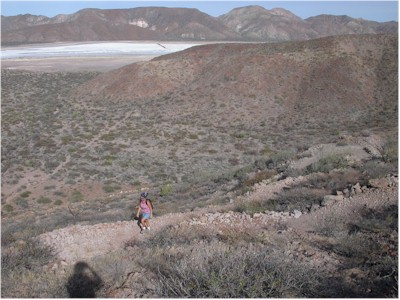 |
|
Hiking up from the Salinas salt flats |
Several of the buildings were actually occupied and being run as a small wilderness resort, although we never saw any people to ask about the resort. It was interesting that the small simple white church nearby was still in order and appeared to be still used regularly. After a brief rest in the shade of the chapel's front steps, we retraced the miles we'd come, finally reaching the anchorage at dusk.
We all recharged ourselves that evening after our grueling hike with huge plates of spaghetti made with fresh chocolate clams plucked from the bay earlier that day. Delicious!
The following day was spent at Isla Carmen just napping and reading and baking bread in the continued cool overcast weather. Then the next we said goodbye to our friends on Whistledown as they were heading back to Escondido to keep their boat there for the summer while they went home to work. As always, we made plans to catch up somewhere in the future.